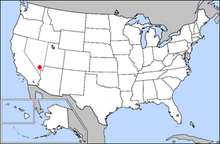The Vegas Valley leopard frog (Lithobates fisheri), also known as the Las Vegas leopard frog, is an extinct species of frog.[1] It once occurred in the Las Vegas Valley, as well as Tule Springs, Clark County, southern Nevada in the United States, at elevations between 370 and 760 m (1,210 and 2,490 ft).[3][4][5][6] It was believed to be the only frog endemic to the United States to have become extinct in modern times.[7]
| Vegas Valley leopard frog | |
|---|---|
| Scientific classification | |
| Domain: | Eukaryota |
| Kingdom: | Animalia |
| Phylum: | Chordata |
| Class: | Amphibia |
| Order: | Anura |
| Family: | Ranidae |
| Genus: | Lithobates |
| Species: | †L. fisheri
|
| Binomial name | |
| †Lithobates fisheri (Stejneger, 1893)
| |

| |
| Former range (in red) | |
| Synonyms | |
|
Rana fisheri | |
History
editA. Vanderhorst collected 10 specimens of this species at Tule Springs on January 13, 1942. These frogs were believed to be the last recorded specimens of the Vegas Valley leopard frog, and are now in the University of Michigan Museum of Comparative Zoology collection.[8][9] The Vegas Valley leopard frog was considered extinct[6] after extensive searches have failed to locate the species.[1]
Taxonomy
editIn 2011, a genetic analysis using DNA from preserved museum specimens of the Vegas Valley leopard frog revealed it is 100% identical genetically to the northwestern Mogollon Rim populations[10] of the Chiricahua leopard frog (Lithobates chiricahuensis), which is extant but threatened.[11] While it has been extirpated from the Las Vegas area, the frog is no longer considered extinct because it is the same species as the Chiricahua leopard frog.[12] According to nomenclatural priority, the northwestern Mogollon Rim population of L. chiricahuensis, described in 1979, is referable to the 1893-described, extinct population of the species, L. fisheri.[10] L. chiricahuensis may remain a valid taxon for the southern and eastern range of the Chiricahua leopard frog.[10] Though what many may assume is that just because an identical species of the Vegas Valley leopard frog was discovered, many may not know that the Chiricahua leopard frog is actually endangered and listed under the federal threatened page. The claim that L. fisheri is synonymous with L. chiricahuensis has for the most part been rejected after the fact.[1]
Apparently, two separate species are within the L. fisheri/L. chiricahuensis complex - L. fisheri, comprising the former Vegas Valley leopard frogs near Las Vegas and the Chiricahua leopard frogs from the Mogollon Rim, and L. chiricahuensis, comprising the Chiricahua leopard frogs from the southern and eastern portions of the range in Arizona and New Mexico. The status of the Chiricahua leopard frog in northern Mexico may be uncertain, and this may be yet another separate lineage. The L. fisheri/L. chiricahuensis complex has a close relationship with an unnamed leopard frog species called "Lithobates species 2" known from San Luis Potosí, Mexico.
References
edit- ^ a b c d IUCN SSC Amphibian Specialist Group. 2022. Lithobates fisheri. The IUCN Red List of Threatened Species 2022: e.T19148A54357815. https://dx.doi.org/10.2305/IUCN.UK.2022-2.RLTS.T19148A54357815.en. Accessed on 15 December 2022.
- ^ "Lithobates fisheri. NatureServe Explorer 2.0". explorer.natureserve.org. Retrieved 15 December 2022.
- ^ Linsdale, J. M. (1940). "Amphibians and reptiles of Nevada". Proceedings of the American Academy of Arts and Sciences. 73 (8): 197–257. doi:10.2307/25130182. JSTOR 25130182.
- ^ Stebbins, R. C. (1951) Amphibians of western North America. University of California Press, Berkeley, California.
- ^ Stebbins, R. C. 1985. A field guide to western reptiles and amphibians. Houghton Mifflin Co., Boston, MA.. Mild. Nat. 77:323–355 ISBN 039538253X.
- ^ a b Jennings, R.D., Riddle, B.R. and Bradford, D. (1995) Rediscovery of Rana onca, the relict leopard frog, in southern Nevada with comments on the systematic relationships of some leopard frogs (Rana pipiens complex) and the status of populations along the Virgin River. Unpublished report.
- ^ "'Extinct' frog was under our noses all the time". New Scientist. June 17, 2011. Retrieved June 17, 2011.
- ^ Platz, J. E. (1984) Status report for Rana onca Cope. Unpublished report prepared for Office of Endangered Species, U. S. Fish and Wildlife Service, Albuquerque, New Mexico.
- ^ Center for Biological Diversity and Southern Utah Wilderness Alliance (2002) Petition to list the relict leopard frog (Rana onca) as an endangered species under the Endangered Species Act. biologicaldiversity.org
- ^ a b c Hekkala, Evon R.; Saumure, Raymond A.; Jaeger, Jef R.; Herrmann, Hans-Werner; Sredl, Michael J.; Bradford, David F.; Drabeck, Danielle; Blum, Michael J. (2011). "Resurrecting an extinct species: Archival DNA, taxonomy, and conservation of the Vegas Valley leopard frog". Conservation Genetics. 12 (5): 1379. doi:10.1007/s10592-011-0229-6.
- ^ Bhanoo, S. N. A frog endangered but extinct no more. New York Times June 17, 2011. Accessed June 17, 2011.
- ^ "Breathing life into an extinct species". Machines Like Us. June 17, 2011. Archived from the original on July 21, 2011. Retrieved June 17, 2011.
Further reading
edit- Hillis, D.M., Frost, J.S., & Wright, D.A. (1983). Phylogeny and biogeography of the Rana pipiens complex: A biochemical evaluation. Systematic Zoology' 32: 132–143.
- Hillis, D.M. (1988). Systematics of the Rana pipiens complex: Puzzle and paradigm. Annual Review of Systematics and Ecology 19: 39–63.
- Hillis, D.M. & Wilcox, T.P. (2005). Phylogeny of the New World true frogs (Rana). Mol. Phylogenet. Evol. 34(2): 299–314. doi:10.1016/j.ympev.2004.10.007 PDF fulltext.
- Hillis, D. M. (2007). Constraints in naming parts of the Tree of Life. Mol. Phylogenet. Evol. 42: 331–338.

